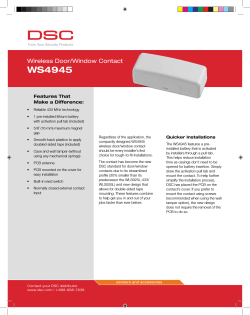
DSC 200 F3
Differential Scanning Calorimetry DSC 200 F3 DSC 200 F3 Maia® - Principle of operation Differential Scanning Calorimetry Differential Scanning Calorimetry Applying this technique, a sample is The new DSC 200 F3 Maia® com- (DSC) is one of the most frequently placed inside a crucible which is bines the advantages of modern used techniques in the field of ther- then placed inside the measurement technology, high sensitivity and a mal characterization of solids and cell (furnace) of the DSC system robust, easy-to-operate work horse. liquids. along with a reference pan which is Tests can be carried out in the normally empty. By applying a con- maximum temperature range The DSC method can be used for trolled temperature program (iso- between –170 °C and 600 °C. the analysis of energetic effects such thermal, heating or cooling at con- as: stant rates), caloric changes can be The key components of the DSC • melting/crystallization behavior characterized. 200 F3 Maia® are the new DSC heat flux sensor and a new furnace. • solid-solid transitions • polymorphism Rapid analyses, easy handling and • degree of crystallinity high significance for research, devel- The sensor of the DSC 200 F3 • glass transitions opment and quality control are only Maia® combines high stability, • cross-linking reactions some of the advantages of this ana- improved resolution and fast re- • oxidative stability lytical technique. Many standards sponse time. Laser-guided welding • decomposition behavior (ASTM, DIN, ISO, etc.) are available processes for the sensor disks and • purity determination for specific material-, product- and thermocouple wires yield true sensi- • specific heat characteristic-oriented applications, tivity and robustness. evaluations and interpretations. DSC 200 F3 Maia® with Automatic Sample Changer (ASC) 2 The heating wires of the newly gas outlet developed furnace surround the entire sensor plate. They are arranged in such a way that no temperature gradients occur in or above the sensor disk. This arrangement is the sample basis for a highly homogeneous heat flow to the sample and reference pans from all sides and therefore monolithic reference disk sensor also for a highly stable baseline and an excellent signal-to-noise ratio. Protective and purge gas inlets are, of course, standard features of the silver furnace insulation unit. gas preheating purge gas inlet zone For improved cooling times and subambient temperature tests, various cooling options such as forced air, cooling block intracooler or liquid nitrogen cooling systems are available. Of course, a versatile gas switching and flow control system are also available. For routine applications we offer an Automatic Sample Changer (ASC) for up to 20 samples and references, also in different crucible types. Technical Specifications (subject to change) Temperature Range: -170 °C to 600 °C Heating rates: 0.001 K/min to 100 K/min Cooling rates: 0.001 K/min to 100 K/min (depending on temp.) Sensor: Heat flux system Measurement range: 0 mW to ±600 mW Temperature accuracy: 0.1 K Enthalpy accuracy: < 1% Cooling options: Forced air LN2 Intracooler Atmospheres: oxid., inert (static, dynamic) Automatic Sample Changer: for up to 20 samples and references (optional) 3 DSC 200 F3 Maia® - Proteus® Software The DSC 200 F3 Maia® runs under a 32-bit Windows® operating system which includes everything you need to carry out a measurement and evaluate the resulting data. Through the combination of easy-to-understand menus and automated routines, a tool has been created that is extremely user-friendly and, at the same time, allows sophisticated analysis. General Software Features: •Windows® operating system: fully compatible with other Microsoft® programs •multi-tasking: simultaneous measurement and evaluation •multi-moduling: operation of different instruments with one computer •combined analysis: comparison and/or evaluation of DSC, TG and TMA and DMA measurements in one plot •labeling: input and free placement of text elements •calculation of 1st and 2nd derivative •selectable scaling •graphic and data export •selectable colors and line types •storage and restoration of analyses •Macro recorder (option) •context-sensitive help system •temperature calibration •compatible with advanced software packages (Peak Separation, Thermokinetics) • Software produced by iso-certified company ��������������������� ���������� 4 DSC Features: •determination of onset, peak, inflection and end temperatures •automatic peak search •transformation enthalpies: analysis of peak areas (enthalpies) with selectable baseline and partial peak area analysis and consider ation of mass changes •comprehensive glass transition analysis •automatic baseline correction •degree of crystallinity •specific heat determination (option) Advanced Software (options) • Peak Separation Software: allows accurate separation and evaluation of overlapping first order transitions • NETZSCH Thermokinetics: allows advanced characterization of reactions and kinetic parameters on the basis of multiple-step kinetic analysis for up to 16 curves and provides predictions of the process • DSC Correction: evaluation of exo- and endo thermal effects under consid eration of system time constants and thermal resistances 5 DSC 200 F3 Maia® – The Solution Application Fields The DSC 200 F3 Maia® can be research tool. Furthermore, due to employed for the characterization of the easy operation, fast analysis time a great variety of materials and and standardized evaluation applications including polymers, procedures, the DSC 200 F3 Maia® is pharmaceuticals, textiles, foods, cos- optimized for application in quality metics, and so on. assurance and failure analysis laboratories. For researchers in fields such as automotive, clothing, drugs, and so on, the technique employed by this instrument is a fast and reliable Ethylene-Propylene-Diene-RubberMixture (EPDM) The thermal behavior of an EPDM rubber mixture was measured between –125 °C and 160 °C at 10 K/min. The glass transition was detected at –53.6 °C. The melting above the glass transition (peak temperature at 31.4 °C) is typical for the behavior of a sequence-type EPDM. The further endothermal effects (at 98.6 °C and 110.3 °C) are due to the evaporation of processing agents. The presentation in the separate window clearly shows the high sensitivity of the DSC 200 F3 Maia® even for small energetic effects (0.43 J/g). 6 Polyethylene (PE) PE materials such as high-density polyethylene (HDPE) are often used for the production of containers for packaging. Differential scanning calorimetry is often used to characterize the melting behavior of such materials, but the DSC 200 F3 Maia® can do even more. Due to its excellent low-temperature performance and outstanding sensitivity, the system also allows the detection of the glass transition (at -119.9 °C). This extremely weak step in the DSC-curve is presented in the embedded picture in more detail. Oxidative Induction Time (O.I.T.) Analysis of the thermal stability of polymers is important for materials under thermal load such as polymer insulation for electronics. Determination of the oxidative induction time (O.I.T.) is a standardized technique which can be easily carried out using the DSC 200 F3 Maia®. Presented here is a measurement on PE heated to 210 °C under inert (nitrogen) conditions. After a five-minute equilibration time, the atmosphere was switched to oxygen; the sample then began to degrade after 71 minutes under oxidizing conditions. 7 DSC 200 F3 Maia® – Accessories and Customer Support DSC - Accessories The DSC 200 F3 Maia® can be control, the DSC 200 F3 Maia® can equipped with various accessories be equipped with a gas flow control and extensions for optimum adjust- system for up to three different ment of the system to your require- purge/protective gases. Routine ments. measurements are facilitated con- Various cooling systems (forced veniently with the automatic sample air via compressor or pressurized changer (ASC) for up to 20 samples air) can be used to cool the fur- and references, also in different nace back to room temperature. crucible types. A wide range of Subambient temperatures (down crucibles (aluminum, silver, gold, to -40 °C) can be achieved with the copper, platinum, alumina, zirco- cost-effective intracooler. The liquid nia, graphite, stainless steel, etc.) is nitrogen cooling system allows tests available for nearly all possible at subambient temperatures down applications and materials. to –170 °C. For accurate gas flow Global Customer Support & Service Network State-of-the-art technology com- and industry. A wide range of dif- NETZSCH is the fastest-growing bined with optimum customer ferent seminars, users’ meetings, company in the field of thermal support are the trademarks of or individual training programs are analysis and thermophysical prop- NETZSCH. Our training department available to assist you in achieving erties testing in the world. This can provides a complete range of pro- optimum performance and benefit be attributed not only to our supe- grams tailored to the needs of our from your thermal analysis system. rior technology and quality, but also customers in research, education to our unmatched pre- and aftersales service network. NETZSCHcertified staff at 45 service centers around the world provide fast and reliable customer support including qualified installation and calibration services and maintenance contracts. Finally, our applications laboratories offer contract testing and support on even the most specific questions. 9 High-Temperature Applications The DSC 200 F3 Maia® allows tests up to 600 °C with excellent baseline stability and reproducibility. Presented here are three runs on a mixture of crystalline SiO2 (quartz) and potassium sulphate (K2SO4). The result clearly proves the outstanding temperature and enthalpy reproducibility of this cost-effective differential scanning calorimeter even at the limits of the temperature range. Curing of a Thermosetting Resin Analysis and optimization of the Sample: Glass Fiber Filled Resin curing process of thermosets can be easily carried out using differential scanning calorimetry. Presented here is a measurement on a glass fiber filled epoxy measured in the DSC 200 F3 Maia®. The two-step exothermal cross-linking reaction slightly above the glass transition (at 101.5 °C) is clearly visible during the first heating of the sample. After a controlled cooling at 5 K/min, the sample was heated a second time. In comparison to the first heating the glass transition is shifted to 142.4 °C in the second heating. 8 advantage in polymers The new DSC 200 F3 Maia® is the The key features of the ideal tool for day-to-day work in DSC 200 F3 Maia® are: your laboratory. The system is generally employed for: • Smart-Running • Top Quality • Product Development • Easy to Use • Quality Assurance • Wide Range of Accessories • Failure Analysis • Low Cost of Ownership The DSC 200 F3 Maia® forms part NETZSCH additionally offers a full of the NETZSCH polymer series of range of high temperature thermal instruments. Together with the TG analysis instruments for tempera- 209 F3 Tarsus (thermogravimetric tures between -260 °C and 2800 °C, analyzer), the TMA 202 (thermome- including dilatometers, thermobal- chanical analyzer), the DMA 242 ances, DTA/DSC systems and STA (dynamic-mechanical analyzer), the (TG-DSC) systems. DEA 230/231 series (dielectric analyzers) for cure monitoring and other For thermophysical properties tests DSC and TGA systems, a full-scale (measurement of the thermal diffu- thermal analysis of your materials sivity/conductivity), NETZSCH offers and parts can be carried out. a broad range of heat flow meters, flash devices and other TCT sys- NGB · DSC 200 F3 · E · 2000 · 1108 · LH tems. NETZSCH-Gerätebau GmbH Wittelsbacherstraße 42 · 95100 Selb/Germany Phone: +49 9287 881-0 · Fax: +49 9287 881-505 E-mail: at@netzsch.com www.netzsch.com
© Copyright 2025












